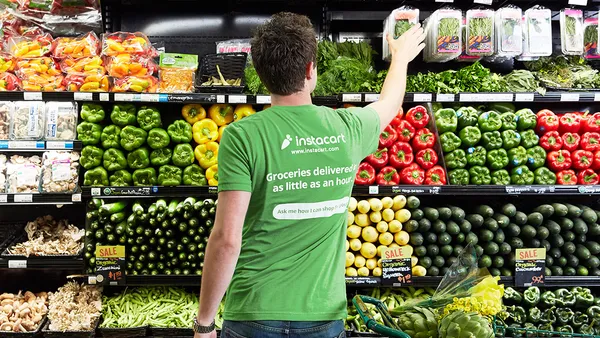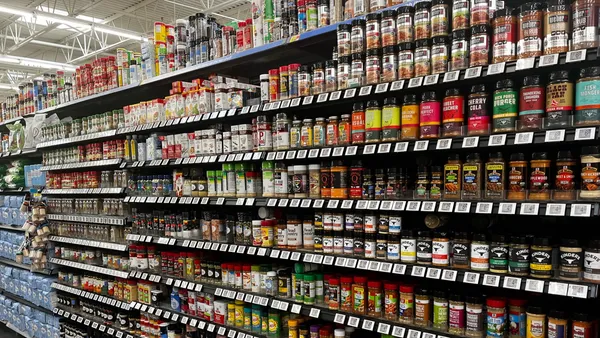- Minimizing lost sales – and potentially lost customers – due to out-of-stocks is more critical than ever as customers spend more in fewer shopping trips and competitive alternatives expand.
- The weather affects consumers and their purchasing decisions on a daily basis; no other external variable shifts store-level sales trends as immediately, frequently, and meaningfully.
- Weather analytics help store managers, category managers, and/or replenishment systems better align inventories with expected demand trends, rather than restocking stores based on recent or historical sales levels.
While the COVID-era landscape has increased the share of overall food dollars being spent at retailers for in-home meals, it has also led to unplanned or greatly accelerated operational costs (e.g. online ordering capabilities, curbside pickup, labor, etc.), introduced additional supply chain challenges, and raised customer expectations. High levels of customer satisfaction are critical to protecting and growing market share, and nothing puts this in jeopardy more than empty shelves.
Improving availability is important but this goal must be pursued in a cost-effective way. Refining replenishment forecasts to account for key purchasing influencers enables grocers to smartly increase stocks ahead of demand spikes, while safely trimming inventories where demand is falling.
Demand levels fluctuate substantially due to changes in the weather for thousands of items on supermarket shelves. This is especially true for fresh, shelf-stable and frozen products. For many of these products, the weather alone can positively or negatively move overall sales by several percentage points. Larger swings (10% or more) are regularly seen on a day-to-day or week-to-week basis and in specific stores. Whether directly or subconsciously, the conditions outside continuously impact the products that customers purchase. And, because the weather is always changing, shopping lists and mix of items going through the check-out lanes or into online carts are also changing on daily basis.
Historically, many retailers have tried to address these issues by depending on store personnel to make manual adjustments or by having measured and/or forecasted weather (temperature, precipitation, etc.) inserted into their existing systems. Neither approach has been sufficient. Relying on the intuition of store staff is inconsistent and unscalable across the business, and from a systems standpoint, weather information may be interesting but it does not easily translate into demand forecast adjustments.
Grocers should not overlook the weather, even in the face of the pandemic and the major shifts in retail that are underway. The linkage between weather and demand for a product has remained constant during COVID-19. The weather's ability to drive demand up or down is durable, and the size of this weather-driven sales volatility (in units and dollars) has only grown as sales baselines for supermarkets have moved higher.
Capturing more sales by making replenishment smarter
Some leading chains are already effectively applying weather-driven demand metrics to upwardly adjust replenishment volumes for products that will see favorable weather impacts. Using weather analytics to get ahead of expected demand surges enables these grocers to reduce lost sales and the risk of losing dissatisfied customers to competitors.
Here are a couple of examples:
- A supermarket chain secured an in-stock improvement of over 20% by integrating weather-driven demand adjustments into their existing demand forecasting solution at the store/item/day level.
- A grocery/hypermarket retailer captured over €50k in incremental sales in a fresh category over just a 3-day period by increasing replenishment volumes into markets where the weather would be positive for sales.
Using weather-driven demand analytics to target when, where, and how much to boost store-level inventories generates increased sales without increasing costs. Simply over-inventorying stores could have, in theory, produced the results above but also increased inventory costs or shrink/waste levels. This did not happen in either case. In the first example, the grocer increased availability while at the same time reduced overall store-level inventories. In the second case, the retailer collected additional sales in high-demand locations while also lowering shrink for the category by trimming stock levels where unfavorable weather would curtail demand.
Optimizing inventories to account for weather impacts offers a great opportunity to increase the topline and add profit. Grocers can expect to gain a 50 to 200 basis increase in sales by improving demand forecasting accuracy and avoiding lost sales.
Integrate weather analytics to optimize demand forecasts & maximize benefits
Weather data and forecasts will not bring the demand forecast accuracy improvements needed to broadly grow sales and profit. The weather's impacts need to be translated into SKU-level units in order to better highlight adjustments that are manually made for key items or automatically adjust replenishment system outputs in a systematic, scalable, and repeatable way.
Weather-driven demand metrics, developed through multi-year analyses of actual sales by product/store/day and corresponding weather conditions, transform weather data into quantifiable and actionable weather impact insights.
Better demand forecasts mean happier and more loyal customers, improved market share, and increased margins. Every extra dollar of profit is always great especially in the current environment in which grocers are investing more than ever to meet growing demand and the evolving needs of customers (e.g. online shopping capabilities, in-store safety measures, etc.).
Learn more by downloading Planalytics' Factoring the Weather into Grocery Demand Shifts.










